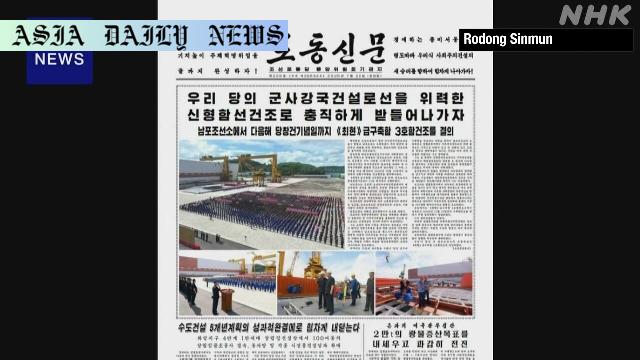Destroyer: North Korea begins building a third 5,000-ton class warship reportedly capable of carrying ballistic missiles by October 10, 2024.
Key Point 1: North Korea begins construction of its third 5,000-ton class destroyer.
Key Point 2: The warship is reportedly capable of carrying ballistic and cruise missiles.
Key Point 3: North Korea aims to enhance its naval strength by completing this project by October 10, 2024.

North Korea Commences Third 5,000-Ton Destroyer Project
North Korea, through its state media, has announced that construction has started on its third 5,000-ton class destroyer. This ambitious naval project, occurring at a shipyard in Nampho, demonstrates the North’s growing investment in military infrastructure. The workers aim to complete the destroyer by October 10, 2024, aligning with the anniversary of the ruling Workers’ Party’s founding. This timeline highlights the nation’s commitment to showcasing its technological progress during a significant political milestone.
Capabilities and Goals of the New-Class Destroyer
Reports suggest that the new destroyers are equipped to carry ballistic and cruise missiles, potentially improving North Korea’s defensive and offensive capabilities in maritime operations. The interest in such large-scale vessels, each weighing 5,000 tons, marks a significant escalation in the country’s naval strategy. Kim Jong Un has explicitly stated plans to build two or more destroyers annually, signaling continuous expansions in the naval fleet as a key military priority. Experts believe these ships may provide strategic leverage in the increasingly tense global arena.
Technical Challenges and Russian Influence
The development of these destroyers has not been without challenges. In May 2023, a launch ceremony for North Korea’s second destroyer ended in partial disaster when the ship tipped onto its side and partially submerged. Following repairs, the ship was operational again, but the incident attracted sharp criticism from Kim Jong Un. Notably, analysts have observed similarities between North Korea’s new warships and Russia’s warship designs. This has led to speculation that Moscow may be aiding Pyongyang with technological expertise and equipment in exchange for ammunition or other military support, showcasing a potential geopolitical collaboration between the two nations.
Geopolitical Ramifications of North Korea’s Naval Expansion
North Korea’s aggressive push to bolster its naval arsenal has significant implications for both regional and global security dynamics. The production of advanced destroyers capable of launching ballistic missiles will undoubtedly heighten tensions in an already volatile East Asian geopolitical environment. Neighboring nations, particularly South Korea and Japan, are likely to strengthen their own defenses in response, further intensifying the arms race in the region. Moreover, North Korea’s actions challenge international efforts to curb weapons development in the peninsula while also illustrating its focus on self-reliance and military dominance.
Future Outlook: North Korea’s Naval Ambitions
Looking forward, North Korea’s commitment to constructing powerful naval vessels highlights its strategic focus on force projection and self-defense. The development of these destroyers not only bolsters the regime’s military strength but also reinforces the leadership’s narrative of technological and industrial self-sufficiency. However, the reliance on foreign expertise—primarily from Russia—further underscores the interconnected nature of modern military advancements. As regional powers monitor these developments, the ongoing growth of Pyongyang’s navy will remain at the forefront of international security discussions, underscoring the need for renewed diplomatic engagement and strategic readiness among neighboring nations.



Commentary
The Significance of North Korea’s Naval Ambitions
North Korea’s decision to invest heavily in naval assets marks a bold strategic pivot aimed at enhancing its deterrence capabilities. The construction of the third 5,000-ton destroyer underscores the regime’s focus on ensuring maritime security and projecting power on an international scale. By embarking on such ambitious projects, North Korea is sending a clear message to the global community about its intent to remain a critical player in regional security dynamics.
Challenges in North Korea’s Naval Development
Despite the symbolic significance of these developments, North Korea’s naval endeavors are fraught with challenges. Incidents, such as the sinking of the previous destroyer during its launch, highlight the practical limitations in the expertise and infrastructure needed to support such advanced projects. While the vessel was eventually repaired, this episode suggests that the pace at which North Korea is pursuing its goals may exceed its technical reach, leaving room for potential failures in future undertakings. Such lapses could strain the regime domestically, especially if resources are diverted away from pressing socio-economic concerns.
Broader Implications for Regional Stability
On a broader level, North Korea’s naval advancements are likely to fuel an arms race in East Asia. Nations such as South Korea, Japan, and even the United States may respond with heightened military spending and increased regional deployments. Furthermore, the speculated collaboration between North Korea and Russia raises additional concerns about the alignment of authoritarian regimes in challenging international norms and redefining power dynamics in the Asia-Pacific region. Ultimately, while North Korea’s pursuit of naval capabilities is impressive, it risks escalating tensions in an already fraught geopolitical landscape.